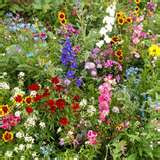Having been questioned about the process to create a vegetable garden, I have compiled several methods that I would find easy to build, and easy to harvest great vegetables.

This type of bed is called the ‘intensive French Mound’. The rows are built up with layers of garden soil, and compost. Many gardeners prefer to ‘double-dig’ this with the thinking that loose soil below will enhance the crops and develop deeper roots. I would find this process very hard work, and therefore, the ‘easy’ choice, at least for me, would not be the intensive French mounds.
Adding organic matter such as compost or packaged garden mixes is essential in creating soil that is high in nutrients, and allows water to get to the roots of the plants. Several garden soil mixes I like are Posy -Power(C), and Paygro.(C) These products provide composted materials, composted manures, and peat to give the plants a great start. (I receive no compensation for mentioning these products. I just like them.)
These raised beds can be raked higher than the paths between the rows, or, as seen here, borders of lumber can be used to keep soil in place. The ‘intensive’ planting is by either planting across the row, of by zig-zaging the plants closely together. This cross row plantings is easy to reach from either side for weeding and harvesting.
Easy reach pathways reduce compaction of the soil. By stepping on the planting beds, air and water are pushed out of the soil, greatly reducing nutrients and oxygen from the plants roots and cause compaction.

This garden has ‘wide rows’. A gardening method that simply scatters seed across the whole row without making lines or worrying about spacing of the seeds. This close scatter seed for lettuce or spinach, works as a living mulch, and keeps soil cool – a requirement for lettuce and spinach. Weeds are kept to a minimum too, as the plants block out light that weeds need.

Wide rows can also be planted with bedding plants in a single, double or even a triple row across the span of the row. By putting plants in rows about 4” – 5” apart, again, more food can be grown in a minimal of space.

New Ideas Garden Blog featured this neat, compact garden style with paved pathways, and all of the beds are accessible from all sides for easy maintenance.

Peas, beans, melons, squash, zucchini, and cucumbers will all benefit from trellis climbing. The vines will be off the ground,and not sprawling all over the garden. Light will be available, and harvesting will be easier. Air flow around the plants will lessen diseases. These trellis can be purchased assembled, or created by using reclaim wood, sticks, or even, PVC piping tied together.
Vertical gardens take advantage of upward growing of many vine vegetables, and allows the main beds to grow other varieties

Grid gardens also referred to as ‘square-foot gardening’ sets a pattern of squares for different crops. Some squares can be plants in the center, one plant, while other sections can be planted at the four corners, rows of three or four, or one row of four right down the center of the square.
Larger vegetables require more space, like Broccoli, Cabbage, and Eggplant. Only one plant per square for these vegetable.


Raised beds can be as deep, or as shallow as needed.
Use untreated wood for these raised versions of gardens. Treated wood is processed with chemicals, and can leach into the food crops. Cedar and redwood have natural resistance to insects and hold up well in the garden. Pine and fir can be used, but may need to be replaced after several years.
Raised beds can be as decorative as needed.
 |
| Vertical mesh fencing adds height for upward growing. |
Other styles of vertical gardening are being promoted in the home
farmden. Take a wall, with many of these systems, and move the garden upward.
 |
| Gutter are installed on wall for shallow leafy vegetables. |
 |
| Cell tray is planted and mounted on Wall. |
 |
| Garden that extends upward on deck or courtyard. |
This was is very creative in planting window boxes, trailing vines, and getting sunlight to the plants. Watering is simplified by grouping these containers together.
Creative ingenuity or necessity have devised ways to extend our vegetable gardens to meet our space features, and provide food for the family. Expressing ourselves with food growing has a way of nurturing our bodies and souls.
.






















.jpg)






















